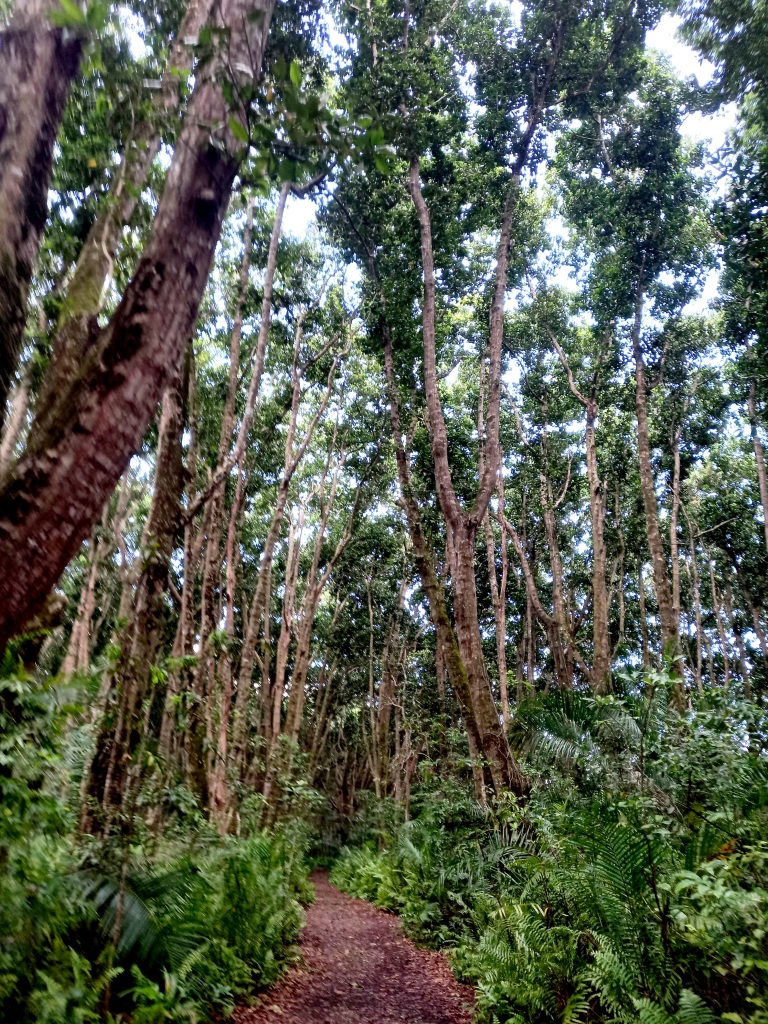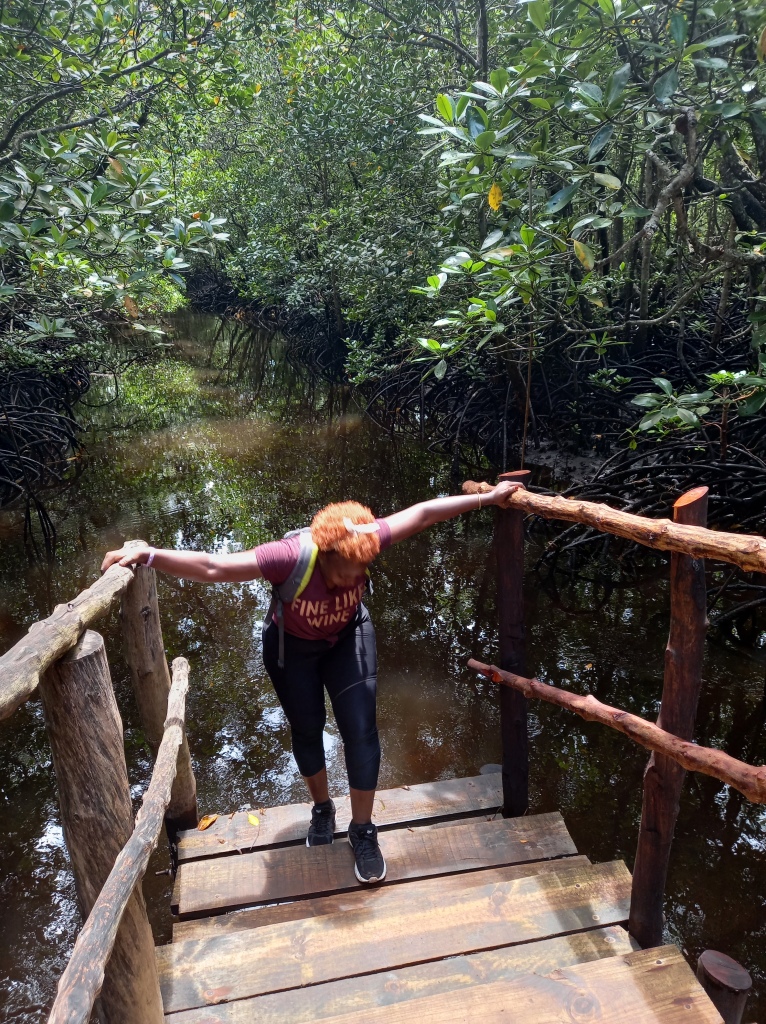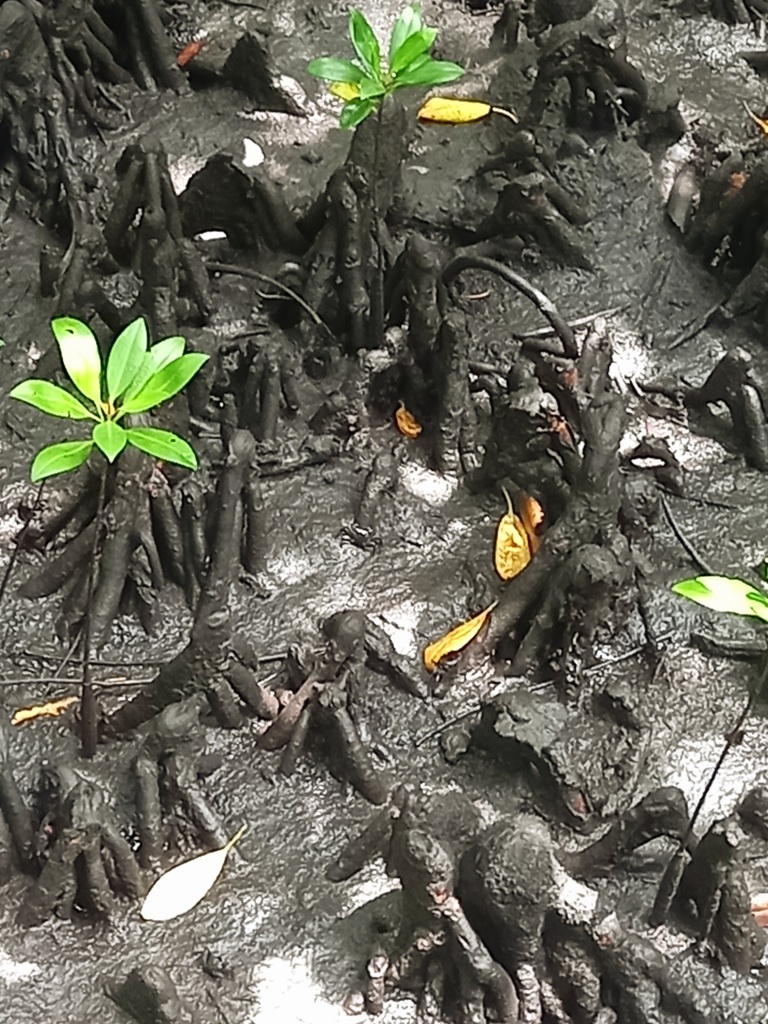Picture this, walking on a suspended wood board in a forest, the air very fresh, devoid of any scent, the birds chirping high in the trees, the sun streaming through the branches to light the way. Your surroundings on either side are trees seemingly suspended by coal-black stems running into the ground with soil so dark, it shimmers. Between the stems running to the ground are scattered small mound-like sculptures. Stay with this image as I try to tell you about my surreal experience walking through the mangrove trees of Jozani Forest in Zanzibar.

According to our tour guide, mangroves make the largest composition of the tree coverage in Jozani forest located on the island of Zanzibar. The Island that arched a place in my heart since 2019 when I first visited has more to offer than its famous blue waters and white sand beaches not forgetting the historic Stone Town. Located on the South-Eastern part of the island, it takes under an hour to drive from Stone town to get to the forest by special hire vehicle and could take longer if you use the “dala dala” (public transport). A ticket for the nature walks costs 25,000 TZ shs (about 39,000 ugx) for foreigners and is paid at the entrance. A few meters walk leads to the reception area where you present your ticket and are assigned a guide. It was raining that morning which cooled down the raging heat of the island. The first part of the forest was serene with the very knowledgeable guide elaborately describing the different tree species by name and history. It is so amazing how one person can store all that information, more like a tree encyclopedia. Together with other tourists, we trod on behind him, awing and oooing at the beauty of the nature that surrounded us. It never gets old, at least for me. Allow me to digress a bit… If you have done the Mabira forest walk- refer to the blog post I did (via Kampala Jinja Highway) or Kalinzu Forest walk/chimpanzee tracking (located in Bushenyi) or any other forest walks you know the feeling. If Kalinzu forest sounds foreign to you and you’re Ugandan, it shouldn’t be. It’s a rain forest located in the Bushenyi district off the Bushenyi Kasese highway just before reaching Queen Elizabeth. It’s one of the hidden gems and under reported touristy places with a lot to offer has a lot to offer. (Couldn’t help myself, its in my home district😊).
Back to Jozani forest, like all tropical rain forests on the African continent, it’s blessed with a variety of animal species the most common and easy to spot being monkeys. We saw a number of these, tribes, and tribes of monkeys. At one spot, we encountered a natural swinging rope. Me being me, I attempted to swing on it unsuccessfully, but it was strong and hung all the way up in a tall tree. The rope was a broken climbing plant that awaited us to enjoy and spice up our nature walk.

We exited the forest onto the main road that comes from stone town headed to the beaches on the Eastern part of the Island. Getting out seemed a bit premature and as if the walk had just started and ended abruptly. Thankfully, we learned the walk wasn’t over. The last and most exciting part of the forest walk is on the other side of the road quite a distance from the reception area. We had to ride there for about 15 to 20 minutes’ drive. We disembarked from the cars and onto a pathway through shrubs and a few minutes ushered us to one of the most scenic views I have ever seen. Insert the image I described at the start of this blog. We had reached the “more interesting” mangrove trees.


I hadn’t intended to write this story but reading a recent blog by one of my favorite bloggers Bikozulu I believe was a sign to share my experience of the mangroves. In my mother tongue, we have a saying “abagyenda bareba” translating to “those who travel see things,”. The scene that was before us brought this saying to mind.
According to the guide, the coal-black stems attached to the trees and running into the soil were exposed roots. The mangroves in that particular area are located about 4-3 kilometers from the ocean. During the high tides, mostly in the evenings and at night, the water moves from the ocean and covers the part of the trees washing away the soil. During the low tides when the water returns to the ocean and the once covered roots are left exposed hence the scene that was before us. I was however dying to know what the mound sculpture-like things in the soil were. These we were told were breathing roots for a particular type of mangroves.


The mangroves have different species and to my recollection, black, red, and white mangroves with differentiating traits that the guide laboured to explain. However, if you ask me, they all looked the same almost.
Some of the seeds one of the species of mangroves are shaped like spears, which when they fall from the tree straight (vertically) into the ground, they germinate into new trees whereas if they fall on the side (horizontally) nothing comes of them.

The boardwalk is a long and winding stretch that takes you a bit further into the forest to give you ample time to take in the surroundings but when we came to the end of it, I didn’t know that I had had enough of it. You know it’s a good thing when you don’t want it to end, such was my experience walking through the mangrove trees of Jozani forest.
While I have tried to explain this experience as best I could, I highly recommend visiting it if you have plans to visit the island sometime.
Fun Facts about Mangroves
- Mangroves are the only species of trees in the world that can tolerate salt water.
- Mangroves have a great capacity to take carbon out of the atmosphere. A patch of mangroves could absorb as much as 10 times the carbon of a similarly sized patch of terrestrial forest, mitigating the effects of sea-level rise.
- Mangroves buffer against rising sea levels and storms and help keep the coastline in place, protecting properties and infrastructure.
- Mangroves can live for up to 100 years and therefore record the effects of changing environmental conditions in their structure and composition. Source: hlw.org.au
This experience is part of my 2021 end-of-year adventures/misadventures. Epic stories to tell but will share others another time. Also, a big shout out to Suleiman the super Zanzibari driver, guide, and photographer, look him up if you’re ever in the Paje beach area.
Until next time Zanzibar, you’re always a treat.





This is beautiful. I love nature and glad you enjoyed yourself.
LikeLiked by 1 person
Thanks Catherine
LikeLike